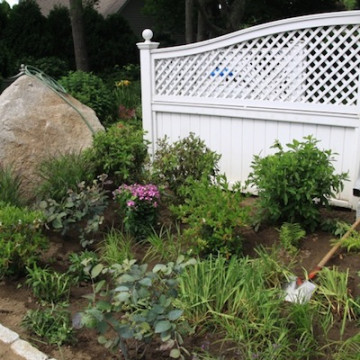Landscape Now: Do Your Own Rain Garden This Summer
Saturday, July 20, 2013
Instead of letting storms ruin your summer fun, get something out of it by putting the rain to work in a rain garden.
What are Rain Gardens?
Rain gardens are depressions in the lawn designed to catch runoff water from roofs or paved surfaces with help from planted shrubs and perennials that catch the water and help return it into the ground. This allows runoff to infiltrate the soil in your yard preventing water from leaving your property and ending up carrying pollutants into local streams and rivers. Along the coast rain gardens can serve as buffers collecting runoff before it heads into salt water ponds or the ocean. Properly sited rain gardens help to moderate flooding by holding excess water and giving it a chance to infiltrate the soil before running into storm drains.
Locating Your Rain Garden
Depending on your site, rain gardens can be positioned in an area directly out from a downspout (at least 25’ from the foundation to keep water from entering the basement) in the lawn. Keep gardens away from septic areas, low, wet areas on the property (you want to encourage water infiltration into the soil which will not happen in a wet, pond area), wells or deep shady spots. In sunny areas with a properly constructed garden ponding should disappear in 4-6 hours and all water will be infiltrated into the soil within 24 hours.
GET THE LATEST BREAKING NEWS HERE -- SIGN UP FOR GOLOCAL FREE DAILY EBLASTSizing Your Garden
Typically the rain garden will be 30-50% of the size of the impervious surface you are draining into the garden. For example if the downspout is catching water off 1200 square feet of roof area your rain garden should be about 480 square feet (40% of 1200 sq. ft.) to catch the runoff. There are more detailed formulas for calculating the size of rain gardens...see URI Cooperative Extension, Rain Gardens: A Design Guide for Homeowners in Rhode Island and UConn Cooperative Extension System, Rain Gardens in Connecticut: A Design Guide for Homeowners and CT NOFA, www.organiclandcare.com.
Drainage in Your Rain Garden
The type of soils you have will determine the depth and drainage materials you will need for your garden. Try a small percolation test where you want to install a garden....dig a test hole 6-12” deep and fill with water...if it has not completely drained in 24 hours you will need to provide additional drainage materials. Typically, for a simple rain garden with good drainage, a depression will be excavated at least 12” deep and building a berm on the downward side if the area slopes. Make sure the material in the excavated bottom is permeable and will allow water to seep through...if not you will need to dig deeper and fill the bottom with crushed stone, place a layer of textile fabric over the stone layer and add soil for planting leaving an approximate 6” depression in the center and sloped areas on the sides. Poorly drained sites will require extensive excavation, several layers of stone, mat, soil and ultimately 3-4” of mulch after the plants are installed.
Plants for Your Rain Garden
This part of the rain garden process should be fun! There are many lists available for choosing your plants, Rhode Island Wild Plant Society (www.riwps.org), New England Wildflower Society (www.newfs.org) and the URI Cooperative Extension Sustainable Tree and Shrub Guide. Several good native choices are: winterberry, blue flag iris, panicum, carex sp., summersweet, lobelia, iris sp., monarda, dwarf fothergilla, Joe Pye weed, interrupted fern, wild geranium and woodland phlox.
Mulching Your Garden
Once the planting is done the entire garden area should be covered with 3-4” of a natural (non-dyed) pine bark mulch. The mulch will help to filter the water, slow the runoff off and help to prevent weeds from growing in the garden. In the event of a heavy storm it would be a good idea to install an overflow pipe on the downside berm so water can escape in an unusual rain event. Periodically, a refreshing of mulch, dead heading and pruning may be necessary for the plants in the garden to thrive. Inspections after a rain event will be wise to monitor how the garden is functioning and completing any additional planting or adjustments to the garden.
Landscaping for Droughts and Water Bans!
In my next article I will detail ways to landscape during droughts and maintaining your gardens and landscapes during water bans. It begins with water conservation, preparing your plants for droughts and selecting plants that will perform well with minimal watering!
“With landscaping you never seem to reach the point when you feel the job is complete.”
Frank Crandall, Horticultural Solutions. Frank is a R.I. resident specializing in coastal landscaping, organic land care, small business consulting, writing, speaking photography and will be submitting biweekly articles about Landscape Solutions. Frank just published his third book, Creating a More Peaceful, Happy and Successful Life! You can read more about his book on his website, www.FrankCrandall3.com. Comments about Frank’s articles are welcome by contacting him at [email protected].
Related Articles
- Landscape Now: 10 Low-Maintenance Trees For Your Yard
- Landscape Now: Organic Lawn Care
- Landscape Now: Organic Landscaping + Taking Care of Soil
- Landscape Now: Low-Maintenance Shrubs For Your Yard
- Landscape Now: Landscaping Ideas From Rhode Island’s Best Gardens
- Landscape Now: How To Recover From Winter Storm Damage
- Landscape Now: How + When To Water Your Yard
- Landscape Now: Beautiful Window Boxes
- Landscape Now: 10 Steps To An Eco-Friendly Landscape
- Landscape Now: Using Rhode Island Native Plants In Your Yard




